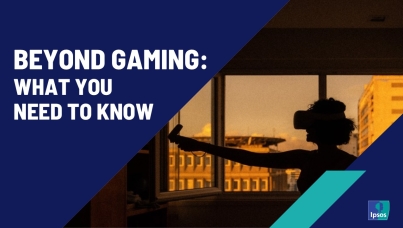Truth vs. Entertainment: The allure of news influencers
What we found was very interesting. Young people are as likely as anyone else to believe influencer content is often full of fake news, but that doesn’t stop them from engaging with it. Despite 77% of 18-34-year-olds stating that ‘fake news’ and misinformation are rife in online news from influencers, over half of them still receive news from these sources daily.1
Why is this?
We see again and again in media content that value wins and the desire to meet core emotional needs drives behaviours. Social media is where young people spend a great deal of their time, and this is only increasing2. Content from influencers on social media caters to the niche interests of young audiences and, crucially, provides emotional engagement. Their needs to be diverted, inspired and entertained3 are thoroughly met – and the next piece of content is always lined up and ready to go.
So, when it comes to news, have we reached the stage where the engagement entertainment they get overrides concerns about misinformation and trust?
When we asked young people directly, it was clear that truth does matter. When presented with a list of potential improvements for news provided by influencers, fact-checking came out on top. They also want news providers and influencers to help them distinguish between fact and fiction4.
A desire for facts and clear labelling of those was true for news consumed across all main platforms. That said, young audiences don’t want all platforms to offer facts in the same way.
When we look at weekly use, TV is as much a part of young people’s repertoire for news as online sources. Young people value news on TV and view TV as a place where they can access detailed, measured reporting. It is also ahead in terms of being seen as acting with good intentions when providing news and information5. On TV, they want more impartiality and less opinionated content, and twice as many place a great deal of trust in news on TV versus influencers6.
Young audiences go to newspapers and magazines for interesting stories, that are accurate and fact-checked.
In contrast, they expect and enjoy opinion-led news from influencers. This type of news is tapping into their need for fresh ideas and perspectives on issues that align with their own, delivered by people they like.
This, of course, leads to risks. Influencers keeping audiences' attention on news by catering to their emotional needs may have its positives, but at a time when tensions are increasing between people who don’t share the same values, this could also have a profound impact on social cohesion7.
The rise of Gen AI may be compounding this.
Awareness and usage of AI are growing, particularly among young people, but so is the concern that distinguishing fact from fiction will become increasingly challenging as the technology develops. AI is already making its way into online news content, even though only 10% are comfortable engaging with news produced mainly by AI with some human oversight8.
That is not to say AI and news are incompatible. Our work with the BBC shows there are nuances to how, when, and why AI is acceptable – value, humanity, and transparency are key9.
Where Gen AI can increase convenience and efficiency, such as podcasts of articles or data-driven news (e.g. weather or scores), this is considered acceptable low stakes. However, opinion-based content, AI newscasters, and the use of tweaked images and video make audiences particularly uncomfortable - all of which are readily available online10.
This may be one of the reasons why young people ask for news stories to be fact-checked more often. They want news providers and influencers to help them distinguish between fact and fiction11.
What does all of this mean for news and young people?
There is an opportunity here to better serve audiences, both online and offline and across different platforms. Established brands can work to increase trust markers and become safe spaces for their audiences, focusing on clear signposting and transparency. We know from previous work that there is likely to be an expectation on platforms and brands to do the heavy lifting, making experiences easy, consistent and seamless.
Exactly how this should be done will depend on context. Understanding news audiences’ interpretation of trust markers is a crucial step in achieving greater transparency. Testing different scenarios with audiences can be particularly useful for determining the nuances and best techniques to make audiences buy into fact-checking, impartiality, and trust in content.
But it is always worth remembering that needs come first. Without the right hooks, editing and tone of voice, ‘real’ news will be speaking to the void.
1. Ipsos Trust in News Half of 16–34-year-olds trust news from online influencers, even with concerns about ‘widespread fake news’ | Ipsos
2. Ipsos iris Ipsos iris | Total understanding of UK online audiences
3. Reuters Institute Digital News Report More than ‘just the facts’: How news audiences think about 'user needs' | Reuters Institute for the Study of Journalism
4. Ipsos Trust in News Half of 16–34-year-olds trust news from online influencers, even with concerns about ‘widespread fake news’ | Ipsos
5. Ipsos Trust in News Half of 16–34-year-olds trust news from online influencers, even with concerns about ‘widespread fake news’ | Ipsos
6. Ipsos Trust in News Half of 16–34-year-olds trust news from online influencers, even with concerns about ‘widespread fake news’ | Ipsos
7. Ipsos Global Trends Global Trends | Ipsos
8. Reuters Institute Digital News Report More than ‘just the facts’: How news audiences think about 'user needs' | Reuters Institute for the Study of Journalism
9. BBC Ipsos ‘Putting Audiences at the Heart of Generative AI’ what-do-people-think-of-generative-ai.pdf
10. BBC Ipsos ‘Putting Audiences at the Heart of Generative AI’ what-do-people-think-of-generative-ai.pdf
11. Ipsos Trust in News Half of 16–34-year-olds trust news from online influencers, even with concerns about ‘widespread fake news’ | Ipsos






